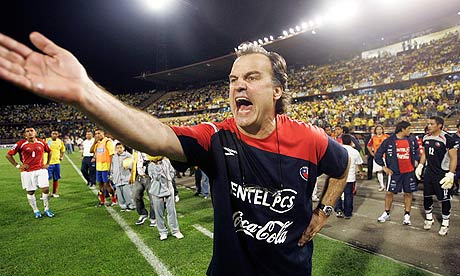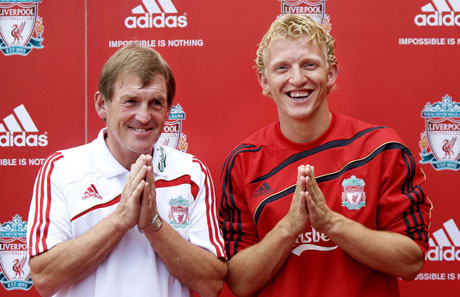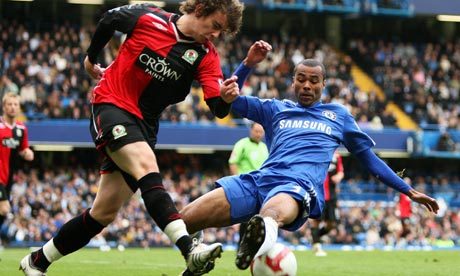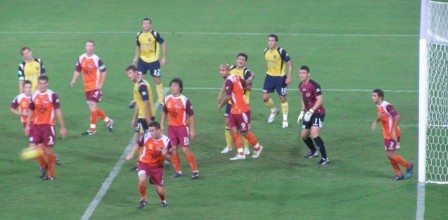-
Recent Articles
The Midfielder as Centerback
 Marcelo Biesla and Josep Guardiola are both managers who play a very high line with their respective sides and who both demand that all players be technically proficient with the ball. Part of playing...
Marcelo Biesla and Josep Guardiola are both managers who play a very high line with their respective sides and who both demand that all players be technically proficient with the ball. Part of playing...Understanding the 4-4-2 Diamond
DEFENCE Despite the fact that there are four ways to play a diamond formation on FM, the differences between them are few and usually subtle. As a starting point, one thing each of them do have...3 at the back and the 4-4-2 Diamond
 Last week Chelsea v Liverpool became the biggest tactical talking point of the season. Liverpool revived the the 3 man defence that Kenny debuted against Stoke. While with the introduction of Torres for £50m...
Last week Chelsea v Liverpool became the biggest tactical talking point of the season. Liverpool revived the the 3 man defence that Kenny debuted against Stoke. While with the introduction of Torres for £50m...How To Set Up A Back Four
 Last year, I wrote a guide about how to play a simple 4-4-2. One of the major components of that is the back four. In fact, most modern formations build upon four defenders; two full backs and two centre...
Last year, I wrote a guide about how to play a simple 4-4-2. One of the major components of that is the back four. In fact, most modern formations build upon four defenders; two full backs and two centre...Building Your Defence: Full Backs
 The modern full back is quickly becoming one of the most important players on the team sheet, infact even back in the days of Brian Clough, fat ed' argued that because of the space these players get in the final...
The modern full back is quickly becoming one of the most important players on the team sheet, infact even back in the days of Brian Clough, fat ed' argued that because of the space these players get in the final...
JOIN 1,224 READERS - SUBSCRIBE NOW TO OUR FOOTBALL MANAGER NEWSLETTER
Get the latest FM news & best community content delivered directly to your e-mail inbox!
Tactical Bible ’08: Building From The Back
Written by: Matt vom Brocke
Category: Strategy
Posted on: May 11, 2007
May 11, 2007
Building from the back
About the ‘back ten’ and the ‘attacking 7’
The unusual sub-title points out at a problem that many players seem to ignore when building a tactic. It is not the often stressed ‘back four’ that makes up the defence: in fact, an effective defence has to begin with the settings of your attacking players alongside the midfield set-up. Conversely, the settings of the defensive players can be a major factor in supporting the attacking efforts and give you some additional players contributing to the attack.
If you are using a very tight formation, you can clearly defend with up to 10 men tracking back (e.g. 4-2-3-1, 4-5-1/4-3-3s), but even if you play with two or three strikers, reasonable settings can increase their support for your defence. On the other hand, give the right instructions to your fullbacks and you can turn them into additional attacking players who will initialise and support your attacking moves effectively. This can lead to superiority of numbers on almost every area of the pitch.
The minimum requirement: ‘the back six’:
When looking into defensive problems, regardless of whether you are using an attacking or defensive tactic, these six players should be looked at (first) as they are the backbone of any solid defence. These are the famous ‘back four’, and maybe less obviously the keeper and the defensive midfielder (DM or MCd). Your defensive performance as a whole will be dependent on the settings these six players have as a unit, and they should not be viewed in isolation.
The keeper
There are three ways to set up a keeper:
- Include him in your mentality system (e.g. mentality 14 in an attacking RoO mindset)
- Exclude him from your mentality system and play him defensively (more or less keeper preset settings)
- Play him as a sweeping keeper (neutral mentality and closing down both ca. 11)
Playing with a sweeper keeper has huge benefits. He will actively try and intercept many trough balls, which is very helpful, primarily for top teams but also for teams that are playing a high or medium line. A good number of dangerous through balls will be intercepted and this can be a massive help for the defence. The downside? Keepers with bad rushing out stats and low anticipation, positioning and decisions will be very error prone.
The key outfield player:
The DMC or MCd. He will win or lose games for you; on his support both defence and attack rely. He should be the first man to look at if things go wrong.
Since the release of FM 07, there have been few tactics working successfully (if any) without a defensive anchor in midfield. Whether he acts as classical DMC in front of the defence or as holding man in an MCd position, getting his instructions right is sometimes half of a successful tactic.
MCd: FWR rarely, crosses mixed or rarely, closing down mixed, CF low
DMC: FWR mixed/rarely, crosses mixed rarely, closing down higher, CF low
Attacking fullback or fullback combos:
If a tactic uses DMs or if you are playing an extremely attacking home game, they can be your attacking players number 6 and 7.
Forward runs: often
RWB: mixed/often
Cross from: mixed
Alternatives: The mixed fullback combo. One attacking, one mixed/staying back. Very good option against difficult opposition.
An example of how to set up and attacking/defending fullback combo by thegooner:
QUOTE
You can use either fullback (Stats important in making your choice)
DR-
Mentality- 5-8(or 2 clicks ahead of your DC’s)
Closing Down-5-8
Passing-12-15(Direct)
Creative Freedom- 3-5
Tackling-Hard(If less than 15 Mixed)
Try Through Balls-Rarely
Cross Ball-Deep
Cross Aim-Far Post(Plays to either the advancing DL or ML)
Marking-Man
Tight Marking-Yes
Hold Up the Ball-Yes(If less than 15 Strength then No)
Forward Runs-Rarely
Run With The Ball-Rarely
Long Shots-Rarely
DR-
Mentality- 5-8(or 2 clicks ahead of your DC’s)
Closing Down-5-8
Passing-12-15(Direct)
Creative Freedom- 3-5
Tackling-Hard(If less than 15 Mixed)
Try Through Balls-Rarely
Cross Ball-Deep
Cross Aim-Far Post(Plays to either the advancing DL or ML)
Marking-Man
Tight Marking-Yes
Hold Up the Ball-Yes(If less than 15 Strength then No)
Forward Runs-Rarely
Run With The Ball-Rarely
Long Shots-Rarely
DL-
Mentality- 8-12
Closing Down-10-15
Passing-Team or Mixed(10)
Creative Freedom- 5-8
Tackling-Hard(If less than 15 Mixed)
Try Through Balls-Rarely
Cross Ball-Mixed
Cross Aim-Near Post(Plays to either the advancing TM or MR)
Marking-Man
Tight Marking-Yes
Hold Up the Ball-No
Forward Runs-Mixed
Run With The Ball-Mixed
Long Shots-Rarely
What this gives is a nice balance and allows the more attacking FB to overlap and ping in crosses the other FB gives extra cover in defence if the attack breaks down. I have seen(in my game) the attacking fullback lose the ball but the DC(left)moves across to cover the space allowing the defending FB(DR)to either drop in alongside the DC(right)or cover the advancing winger. Shape wise looks like 3 DC’S when defending.
I use either a natural DR or a DR/AMR, stifling his settings coupled with the low CF forces him to stay back and hold position. He never gets high ratings avg 6 to 7 max but he does the job well. Worth trying as gives us another dimension. Do not use if playing with offside trap ticked due to set up.
This will work with the same mentality and adjusted FWR settings as well (then offside trap should be possible too). Alternately you could use mixed tackling and set the tackling against wingers via opposition instructions.
Midfield and attack:
This is where defence begins as soon as you lose the ball. These settings determine if your defence is supported strongly by a hard working midfield and attack or being bombed with crosses and runs from the opposition midfield. You will find more detailed suggestions for midfield set-ups in the tactic building approaches articles.
Closing down
To quote wwfan in TT&F 07:
QUOTE
Central Midfielders
Midfielders’ closing down is the only closing down instruction I regulate heavily through the frameworks. Like the defensive line, their closing down links to the framework I have selected. Thus, in the high mentality home framework, they close down to the same setting as the defensive line (17), whereas in the away framework they only close down to four. The logic behind this is that in the home framework they will be high up the pitch most of the time, so heavy closing down is likely to win the ball in or near the opposition’s half, which will be dangerous for them. If they fail to win the ball there is little damage done to the user team, as the defence are still reasonably high up the pitch and should cover any through ball/attacking move. However, in the defensive framework, high closing down for midfielders will be taking place in front of their own penalty area which is exceedingly dangerous should they miss the tackle. So, I prefer them to hold position with low closing down, which forces the AI players to try something, rather than offering them space if my player makes a mistake.
Attackers and Wingers
One of the common user complaints in FM07 is the difficulty of defending deep crosses or balls over the top of the defence. Getting the closing down settings for the forwards and wingers correct seems to counter this. The key, certainly in away formations, is to close down heavily and have easy tackling. This gets your players in position to challenge the AI player in possession, but not to tackle him, unless the tackle is obviously ‘on’. However, you put him under enough pressure to ensure he can’t hit comfortable through balls or quality crosses into the box, as the forward or winger is blocking the ball. Since I employed these settings I have hardly ever conceded a goal from deep passes or crosses.
Also these settings can be supported strongly with the right opposition instructions (see the topic).
As we all know, this system of closing down, combined with RoO, is highly effective for gaining a large amount of possession in midfield and a massive help for the defence. But we also should note there is a different approach: applying less closing down combined with a good defensive set up, forcing the opposition to come at you and try to hit them on the counter. In both cases it is crucial to have the highest closing down setting for the wingers.
Marking:
Tight marking or even man marking in midfield can have massive effects on the defensive performance. Wingers that man mark or tight mark will track back very often and work as additional defensive players if needed, often double-teaming the opposition wingers.
Tackling:
There is a big debate about tackling concerning possession, foul ratios and injuries. However, if your team struggles to keep possession, especially in away games, hard tackling can help. Be it with individual instructions or opposition instructions on certain players.
Forward runs:
Important tweak for setting up a defensive supporting midfield, especially concerning the wingers and DMCs. They can be a very powerful way to adjust the defensive support of the the midfield.
Forwards:
If you set up your target striker (strong or quick) according according to our target men article with a mentality gap to the supporting striker, you will notice that he will drop very deep without possession, almost playing ‘in the hole’, while the other striker will often close down higher up the pitch. This can support your defence strongly as he will close down the space between opposition defenders and midfield and always be free for picking up cleared balls from your own defence.
More detailed suggestions for possible set-ups will be published in the tactic building approaches articles.
Tactical Bible Credits:
Millie, thegooner, wwfan, The Next Diaby. Editor: TND, Millie
About The Author: Matt vom Brocke
Matt’s contribution to FM-B as a whole and the tactical area in particular cannot be over-estimated. The writer of the very well-recieved Communication and Psychological Warfare and Creativo set of tactics, Matt is a key member of the Tactical Think Tank and part of SI’s beta testing Dream Team.
Download Our Tactical Theorems '10 eBook Absolutely Free

Presenting the most comprehensive tactic design and match strategy guide to the Football Manager series ever created!
Written by FM match engine beta testers, it's 60+ pages of easy-to-read concepts and ideologies for getting your team playing exactly how you want each match! It's been downloaded over 100,000+ times to date!
Find out more information about our tactical eBook
and download Tactical Theorems '10 right now!
Written by FM match engine beta testers, it's 60+ pages of easy-to-read concepts and ideologies for getting your team playing exactly how you want each match! It's been downloaded over 100,000+ times to date!
and download Tactical Theorems '10 right now!




